Complete Solutions to PHYSICS of chapter XII BOARDS of Class 12 book with complete answers and questions
| Class 12 | PHYSICS |
| Chapter | XII BOARDS |
| XII BOARDS PREVIOUS YEAR | PHYSICS |
| Number Of Questions | 69 |
| Academic Year | 2023-24 |
What is the direction of the force acting on a charged particle q, moving with a velocity `vec(v)` a uniform magnetic field `vec(B)` ?
View SolutionName the part of the electromagnetic spectrum of wavelength `10^(-2)m` and mention its one application.
View SolutionAn electron and alpha particle have the same de-Broglie wavelength associated with them. How are their kinetic energies related to each other ?
View SolutionA glass lens of refractive index 1.5 is placed in a trough of liquid. What must be the refractive index of the liquid in order to mark the lens disappear?
View SolutionA 500 `mu` C charge is at the centre of a square of side 10 cm. Find the work done in moving a charge of 10 `mu` C between two diagonally opposite points on the square.
View SolutionState the reason, why heavy water is generally used as a moderator in a nuclear reactor.
View SolutionHow does the fringe width of interference fringes change, when the whole apparatus of Young's experiment is kept in a liquid of refractive index 1.3 ?
View SolutionThe plot of the variation of potential difference across a combination of three identical cells in series, versus current is as shown in figure. What is the emf and internal resistance of each cell?
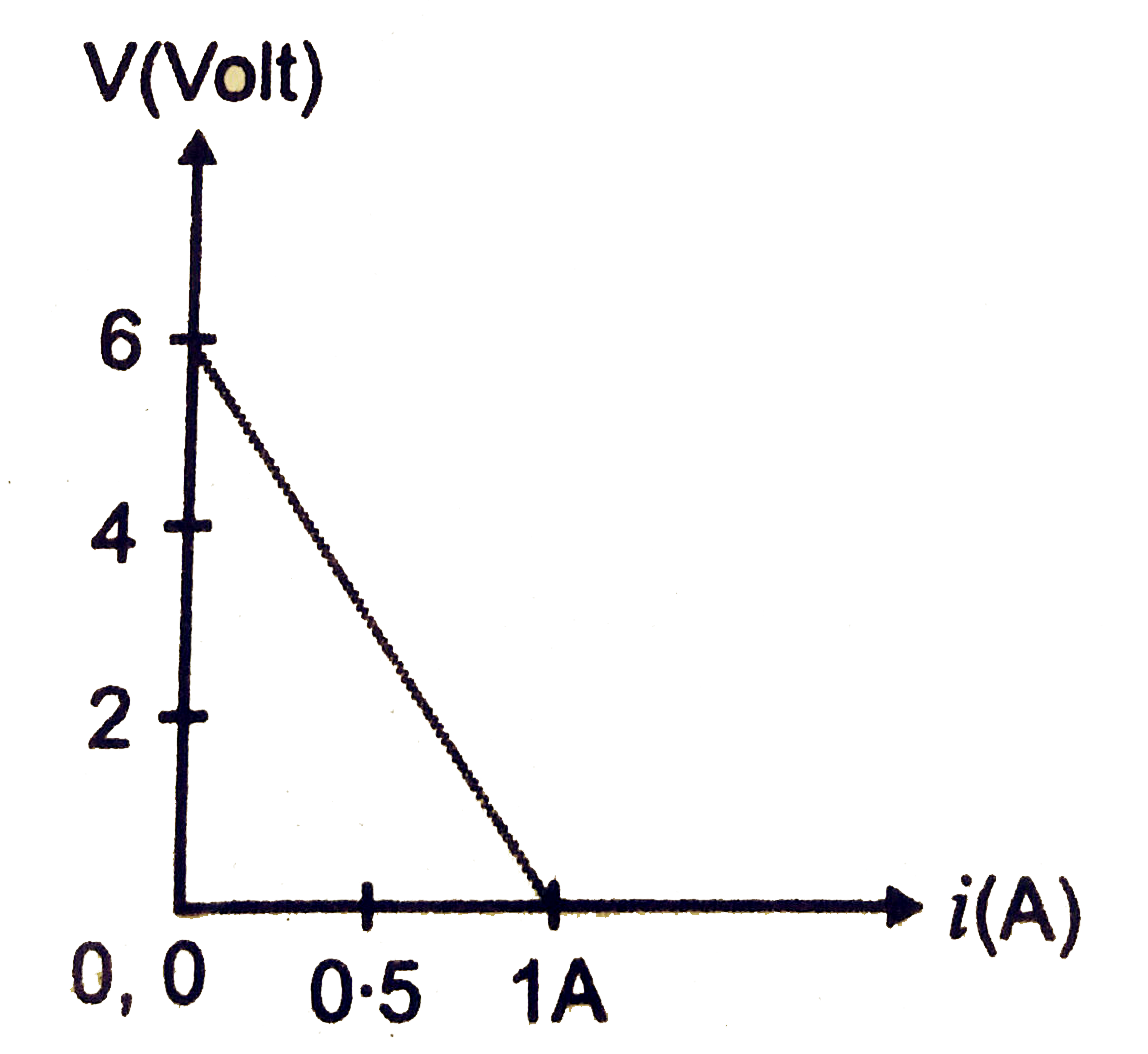
View SolutionDerive the expression for the electric potential at any point along the axial line of an electric dipole.
View SolutionDefine magnetic susceptibility of a material. Name two elements, one having positive susceptibility and the other having negative susceptibility . What does negative susceptibility signify ?
View SolutionThe oscillating magnetic field in a plane electromagnetic wave is given by
`B_(y)=(8xx10^(-6))sin [2xx10^(11)t+300 pi x ] T`
(i) Calculate the wavelength of the electromagnetic wave.
(ii) Write down the expression for the oscillating electric field.
View SolutionProve that an ideal capacitor in an a.c. circuit does not dissipate power.
View SolutionDerive an expression for the impedance of an a.c. circuit consisting of an inductor and a resistor.
View SolutionThe nucleus `.^(23)Ne` deacays by `beta`-emission into the nucleus `.^(23)Na`. Write down the `beta`-decay equation and determine the maximum kinetic energy of the electrons emitted. Given,`(m(._(11)^(23)Ne) =22.994466 am u` and `m (._(11)^(23)Na =22.989770 am u`. Ignore the mass of antineuttino `(bar(v))`.
View Solution(i) A transistor has a current gain of 30. If the collector resistance is `6 K Omega` and input resistance is `1 K Omega`, calculate its voltage gain.
(ii) Why is a semiconductor damaged by strong current ?
View SolutionA convex lens of refractive index 1.5 has a focal length of 20 cm in air. Calculate the change in its focal length when it is immersed in water of refractive index 4/3.
View SolutionA ray of light passing through an equilateral triangular glass prism from air undergoes minimum deviation when angle of incidence is `(3)/(4) th` of the angle of prism. Calculate speed of light in prism.
View Solution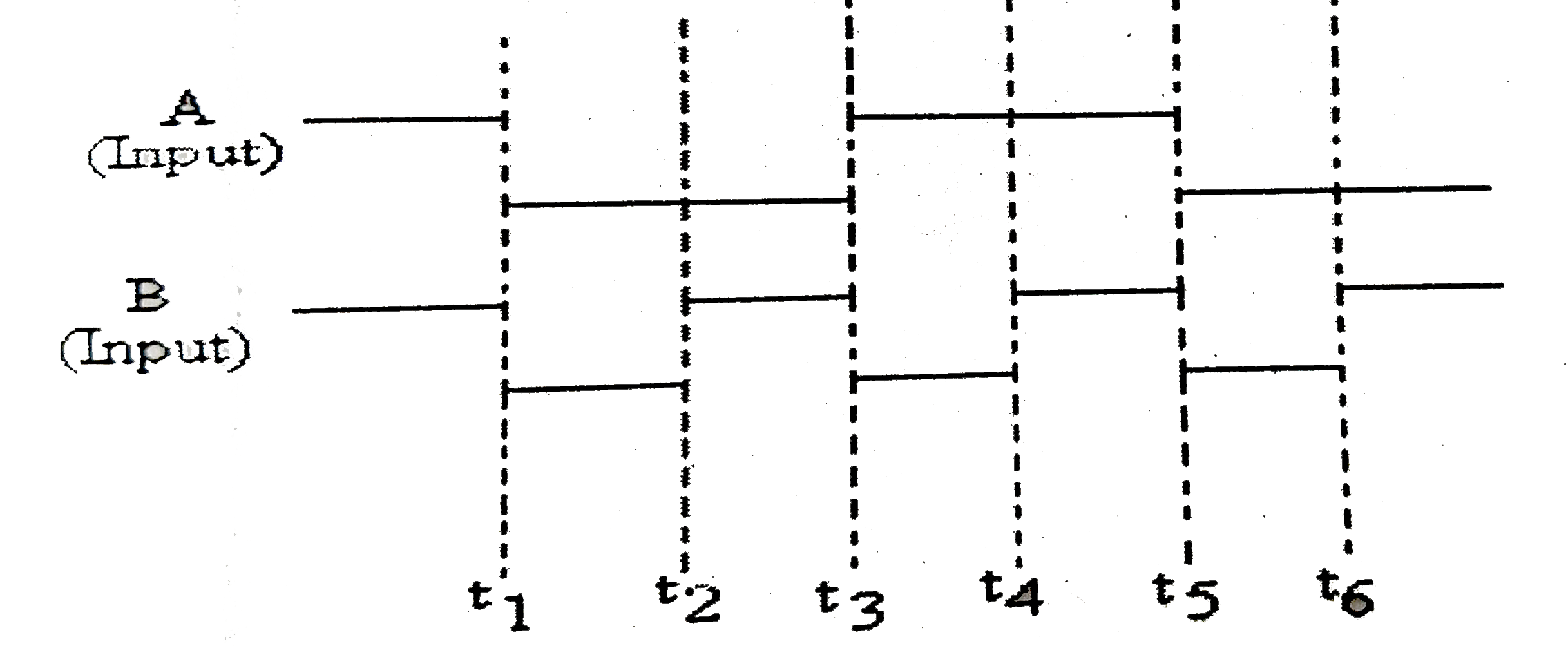
The give inputs A, B are fed to a 2-input NAND gate. Draw the output wave form of the gate.
View SolutionA transmitting antenna at the top of a tower has a height of 36 m and the height of the receiving antenna is 49 m. What is maximum distance between them, for satisfactory communication is the LOS mode? (Radius of earth = 6400 km)
View SolutionHow is a wavefront defined? Using Huygen's construction , draw a figure showing the propagation of a plane wave refracting at a plane surface separating two media. Hence verify Snell's law of refraction.
View SolutionA metallic rod of length l is rotated at a constant angular speed `omega`, normal to a uniform magnetic field B. Derive an expression for the current induced in the rod, if the resistance of the rod is R.
View SolutionDraw a circuit diagram of L.E.D. What are its advantages?
View SolutionAn inductor 200 mH, capacitor `500 mu F`, resistor 10 ohm are connected in series with a 100 V, variable frequency a.c. source. Calculate (i) frequency at which power factor of the circuit is unity (ii) current amplitude at this frequency (iii) Q factor.
View SolutionAn air cored solenoid is of length 0.3 m, area of cross section `1.2 xx 10^(-3) m^(2)` and has 2500 turns. Around its central section, a coil of 350 turns is wound. The solenoid and the coil are electrically insulated from eachother. Calculate the e.m.f. induced in the coil if the initial current of 3 A in the solenoid is reversed in 0.25 s.
View SolutionState Gauss's theorem in electrostatics. Apply this theorem to derive an expression for electric field intensity at a point outside a uniformly charged thin spherical shell.
View SolutionAn e-m wave of wavelength `lambda` is incident on a photo sensitive surface of negligible work function. If the photoelectrons emitted from this surface have the de-Broglie wavelength `lambda_(1)`. Find relation between `'lambda'` and `'lambda_(1)`'-
View SolutionThe energy level diagram of an element is given below. Identify, by doing necessary calculations , which transition corresponds of the emission of a spectral line of wavelength 102.7 nm.
` (##SB_PHY_XII_08_DB_E01_027_Q01.png" width="80%">
View SolutionDraw a plot of the variation of amplitude versus `omega` for an amplitude modulated wave. Define modulation index. State its importance for effective amplitude modulation.
View Solution(a) Using Biot-Savart's law, derive an expression for the magnetic field at the centre of a circular coil of radius R, number of turns N, carrying current.
(b) Two small identical circular coils marked 1,2 carry equal currents and are placed with their geometric axes perpendicular to each other as shown in the figure. Derive an expression for the resultant magnetic field at O.
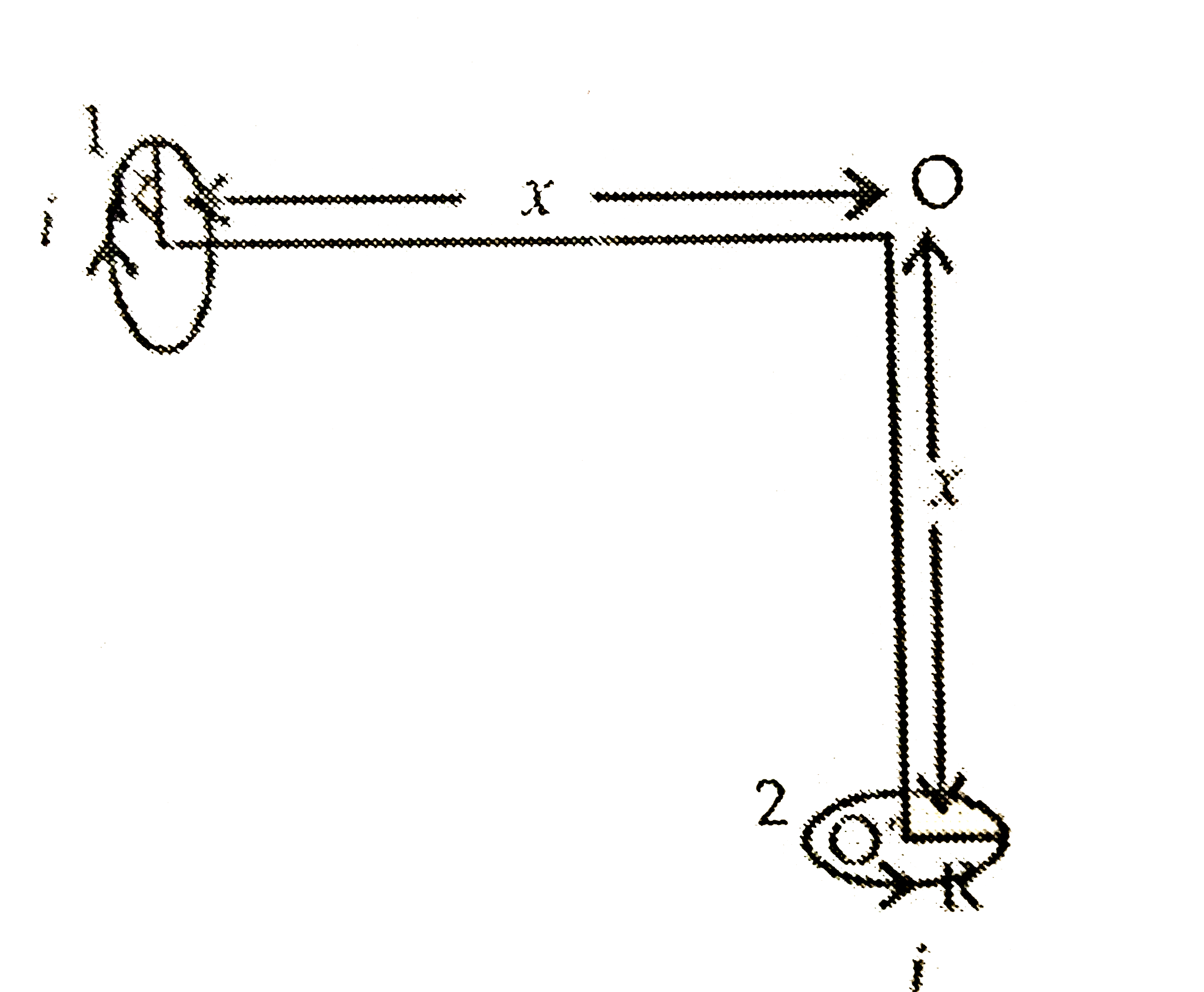
View SolutionDraw a schematic diagram of a cyclotron. Explain its underlying principle and working, stating clearly the function of the electric and magnetic fields applied on a charged particle.
Deduce an expression for the period of revolution and show that it does not depend on the speed of the charged particle.
View Solution(a) For a ray of light travelling from a denser medium of refractive index `n_(1)` to a rarer medium of refractive index `n_(2)`, prove that `(n_(2))/(n_(1)) = sin i_(c)`, where `i_(c)` is the critical angle of incidence for the media.
(b) Explain with the help of a diagram, how the above principle is used for transmission of video signals using optical fibers.
View Solution(a) What is plane polarised light? Two polaroid sare placed at `90^(@)` to each other and the transmitted intensity is zero. What happens when one more polaroid is placed between these two, bisecting the angle between them? How will the intensity of transmitted light vary on further rotating the third polaroid?
(b) If a light beam shows no intensity variation when transmitted through a polaroid which is rotated, does it mean that the light is un-polarised? Explain briefly.
View Solution(a) Using Gauss's law, derive an expression for the electric field intensity at any point outside a uniformly charged thin spherical shell of radius R and charge density `sigma C//m^(2)`. Draw the field lines when the charge density of the sphere is (i) positive, (ii) negative.
(b) A uniformly charged conducting sphere of 2.5 m in diameter has a surface charge density of 100 `mu C//m^(2)`. Calculate the
(i) charge on the sphere
(ii) total electric flux passing through the sphere.
View Solution(a) Derive an expression for the torque experienced by an electric dipole kept in a uniform electric field.
(b) Calculate the work done to dissociate the system of three charges placed on the vertices of a triangle as shown.
Here `q= 1.6 xx 10^(-10)C`.
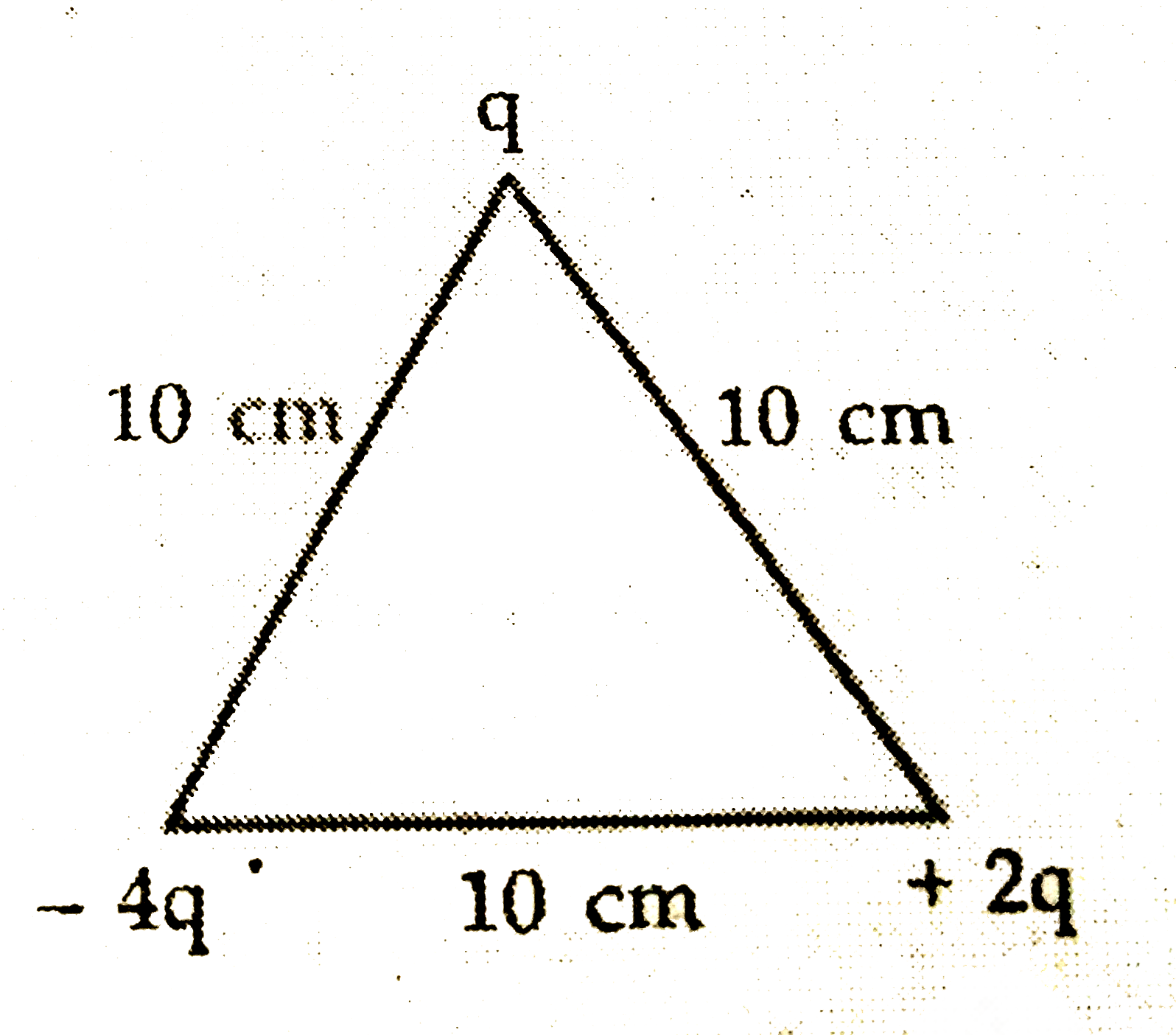
View SolutionState two characteristic properties of nuclear forces.
View SolutionHow does the angle of minimum deviation of a glass prism vary, if the incident violet light is replaced with red light?
View SolutionThe instantaneous current and voltage of an a.c. circuit are given by i=0 sin 3000 t A and v=200 sin 300 t V.
What is the power dissipation in the circuit?
View SolutionWhy should the spring/ suspension wire in a moving coil galvanometer have low torsional constant?
View SolutionWhy does the bluish colour predominate in a clear sky?
View SolutionWhich orientation of an electric dipole in a uniform electric field would correspond to stable equilibrium ?
View SolutionTwo lines, A and B, in the plot given below show the variation of de-Broglie wavelength, `lambda` versus `1//sqrt(V)`, where V is the accelerating potential difference, for two particles carrying the same charge. Which one of two represents a particle of smaller mass?
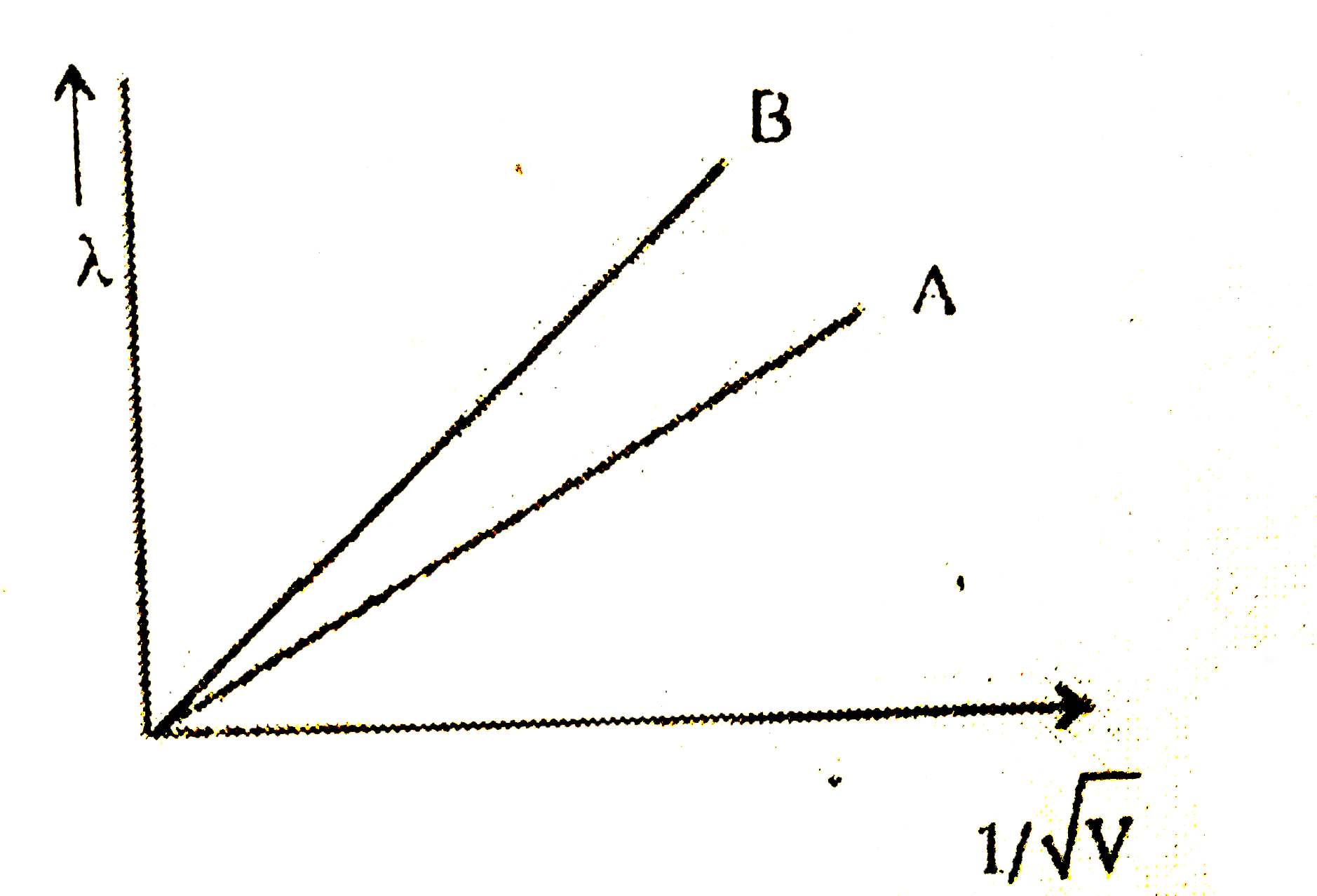
View SolutionState the reason, why GaAs is most commonly used in making of a solar cell.
View SolutionDraw a labelled ray diagram of an astronomical telescope in the near point position. Write the expression for its magnifying power.
View SolutionThe following figure shows the variation of intensity of magnetisation versus the applied magnetic field intensity, H, for two magnetic materials A and B :
(a) Identify the materials A and B.
(b) Why does the material B, have a larger susceptibility than A, for a given field at constant temperature?
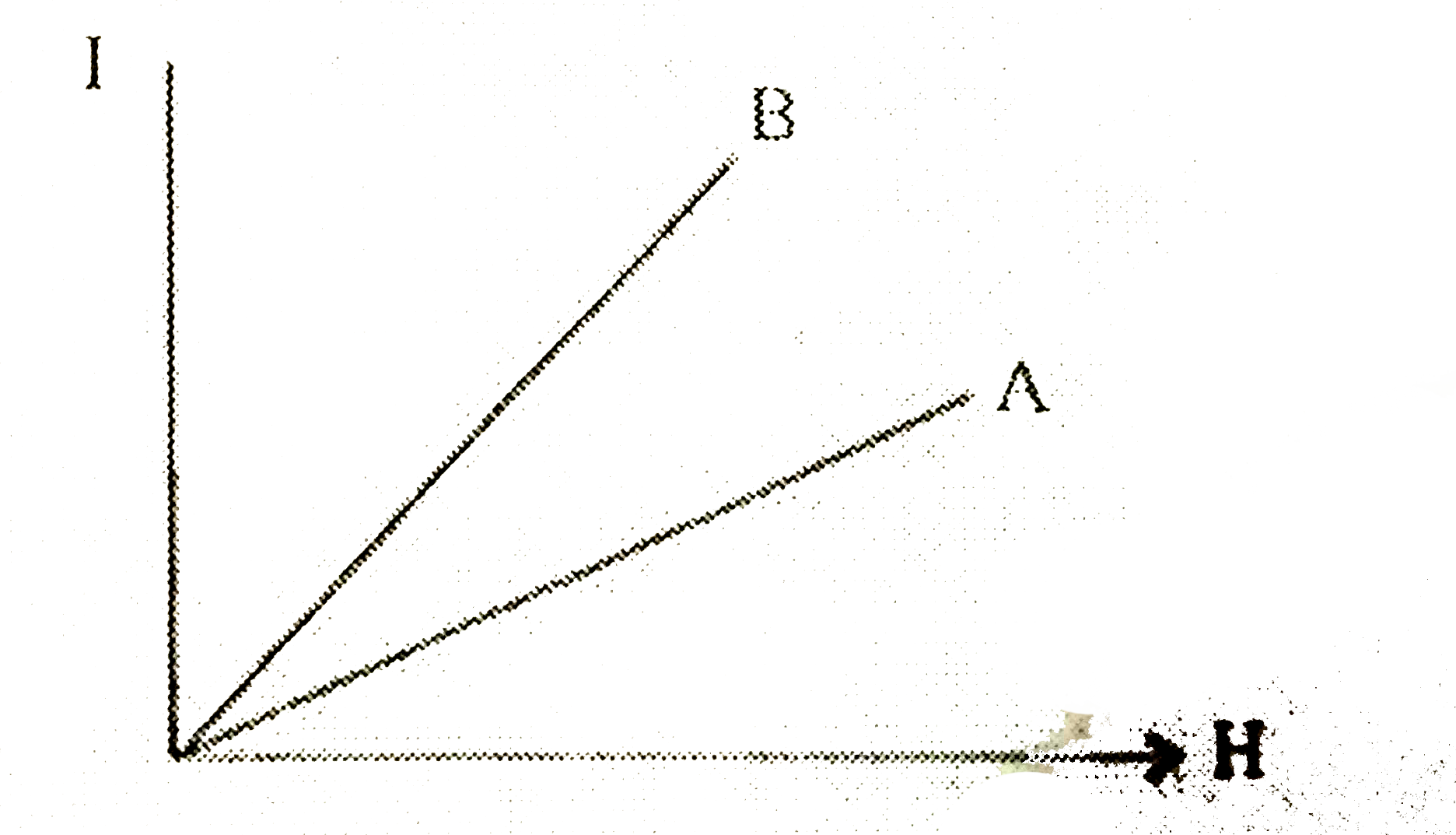
View SolutionTwo metallic wires of the same material B, have the same length out cross-sectional area is in the ratio 1:2. They are connected (i) in series and (ii) in parallel. Compare the drift velocities of electrons in the two wires in both the cases (i) and (ii) .
View SolutionDraw a block diagram of a simple amplitude modulation. Explain briefly how amplitude modulation is achieved.
View SolutionCalculate the amount of energy released during the `alpha`-decay of
`._(92)^(238)Urarr_(90)^(234)Th+._(2)^(4)He`
Given: atomic mass of `._(92)^(238)U=238.05079 u`, atomic mass of `._(90)^(234)Th=234.04363 u`,
atomic mass `._(2)^(4)He=4.00260u , 1u=931.5 MeV//c^(2)`. Is this decay spontaneous?Give reason.
View SolutionUsing Ampere's circuital law, obtain an expression for the magnetic field along the axis of a current carrying solenoid of length l and having N number of turns.
View SolutionDerive an expression for the resistivity of a good conductor, in terms of the relaxation time of electrons.
View SolutionThe circuit arrangement given below shows that when an a.c. passes through the coil A, the current starts flowing in the coil B.
(i) State the underlying principle involved.
(ii) Mention two factors on which the current produced in the coil B depends.
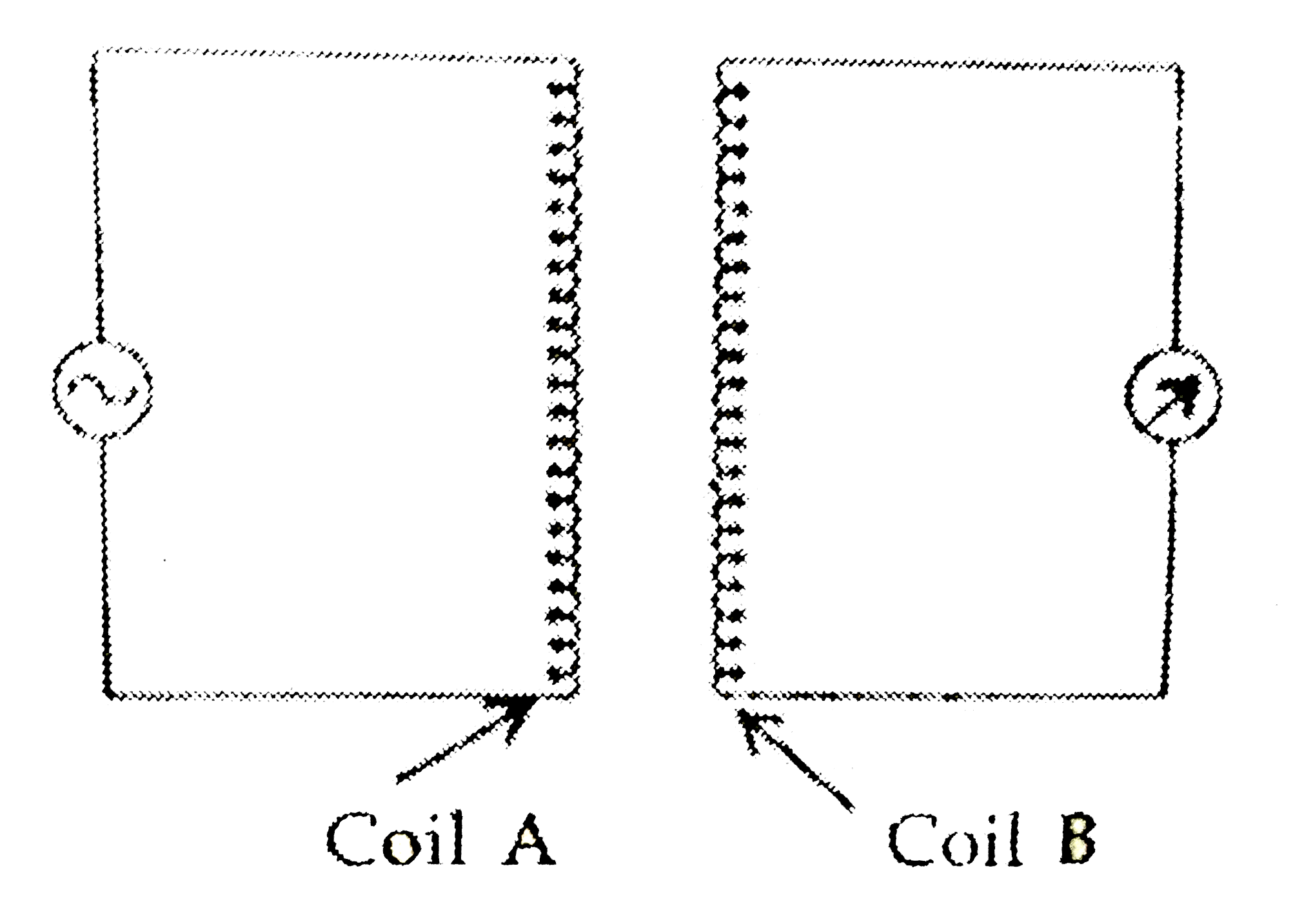
View SolutionA parallel beam of light of wavelength 600 nm is incident normally on a slit of width d. If the distance between the slits and the screen is 0.8 m and the distance of `2^(nd)` order maximum from the centre of the screen is 15 mm. The width of the slit is
View SolutionTwo point charges, `q_(1)=10xx10^(-8)C` and `q_(2)=-2xx10-8C` are separated by a distance of 60 cm in air.
(i) Find at what distance from the 1st charge, `q_(1)`, would the electric potential be zero.
(ii) Also calculate the electrostatic potential energy of the system.
View SolutionTwo point charges 4Q, Q are separated by 1m in air. At what point on the line joining the charges is the electric field intensity zero ?
Also calculate the electrostatic potential energy of the system of charges, taking the value of charge, `Q=2xx10^(-7)C`.
View SolutionWhat does the term LOS communication mean? Name the types of waves that are used for this communication. Which of the two height of tansmitting antenna and height of receiving antenna can effect the range over which this mode of communication remains effective?
View SolutionA message signal of 12 kHz and peak voltage 20 V is used to modulate a carrier wave of frequency 12 MHz and peak voltage 30 V. Calculate the (i) modulation index (ii) side- band frequencies.
View SolutionDistinguish between unpolarised and plane polarised light. An unpolarised light is incident on the boundary between two transparent media. State the consition when the reflected wave is totally plane polarised. Find out the expression for the angle of incidence in this case.
View SolutionDraw the labelled circuit diagram of a common-emitter transistor amplifie : Explain clearly how the input and output signals are in opposite phase.
View SolutionState briefly the underlying principle of a transistor oscillator. Draw a circuit diagram showing how the feedback is accomplished by inductive coupling. Explain the oscillator action.
View SolutionThe ground state energy of hydrogen atom is -13.6 eV.
(i) What is the kinetic energy of an electron in the `2^(nd)` excited state ?
(ii) If the electron jumps to the ground state from the `2^(nd)` excited state, calculate the wavelength of the spectral line emitted.
View SolutionFor what kinetic energy of a proton, will the associated de-Broglie wavelength be 16.5 nm?
View SolutionTo increase the current sensitivity of a moving coil galvanometer by `50%` its resistance is increased so that the new resistance becomes twice its initial resistance. By what factor does its voltage sensitivity change?
View SolutionThe inputs A and B are inverted by using two NOT gates and their outputs are fed to the NOR gate as shown:
Analyse the action of the gates (1) and (2) and identify the logic gate of the complete circuit so obtained. Give its symbol and the truth table.
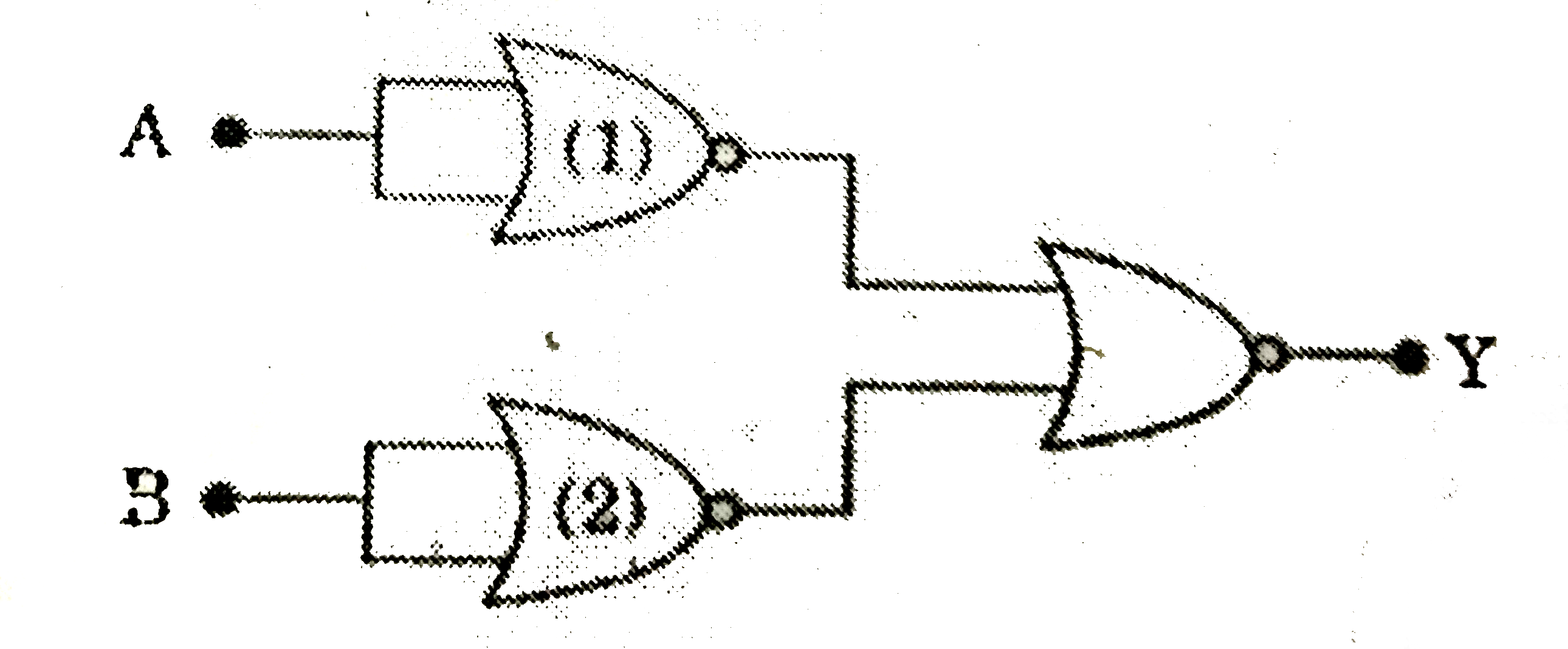
View SolutionA `100 mu F` capacitor in series with a `40 Omega` resistance is connected to a `100 V_(1) 60 Hz` supply. Calculate (i) the reactance (ii) the impedance and (iii) maximum current in the circuit.
View SolutionDerive an expression for the energy stored in a parallel plate capacitor.
On charging a parallel plate capacitor to a potential V, the spacing between the plates is halved, and a dielectric medium of `in_(r)=10` is introduced between the plates, without disconnecting the d.c. source.
Explain, using suitable expressions, how the (i) capacitance, (ii) electric field and (iii) electric field and (iii) energy density of the capacitor change.
View Solution(a) Define electric flux. Write its SI units.
(b) The electric field components due to a charge inside the cube of side 0.1 m are as shown :
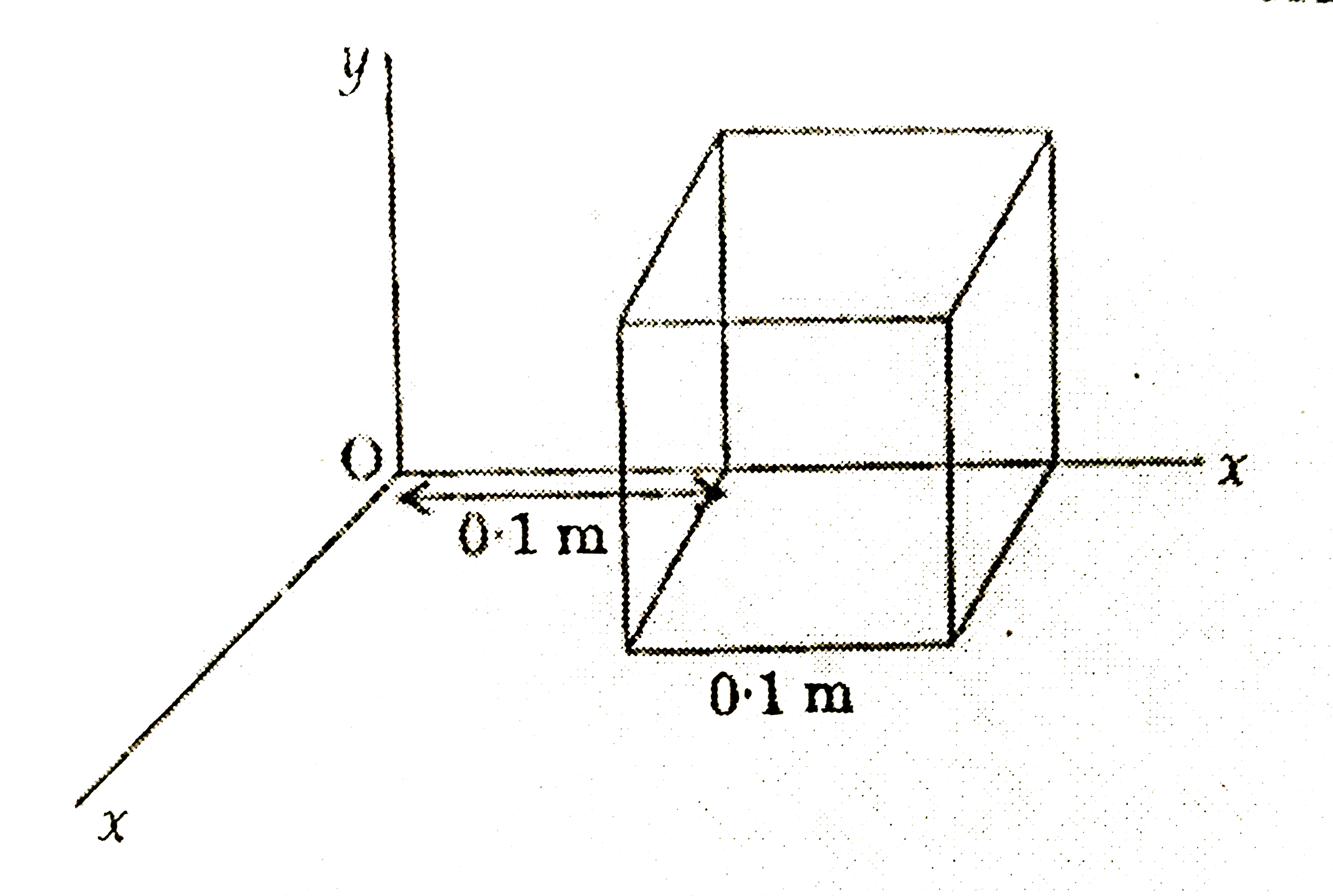
`E_(x)=alpha x, ` where `alpha=500N//C-m`
`E_(y)=0, E_(z)=0`.
Calculate (i) the flux through the cube, and (ii) the charge inside the cube.
View SolutionDerive the lens formula, `(1)/(2)=(1)/(v)-(1)/(u)` for a concave lens, using the necessary ray diagram.
Two lenses of powers 10 D and -5 D are placed in contact.
(i) Calculate the power of the new lens.
(ii) Where should an object be held from the lens, so as to obtain a virtual image of magnification 2?
View Solution(a) what are coherent sources of light ? Two slits in Young's double slit experiments are illuminated by two different sodium lamps emitting light of the same wavelength. Why is no interference pattern observed?
(b) Obtain the condition for getting dark and bright fringes in Young's experiment. Hence write the expression for the fringe width.
(c) If s is the size of the source and its distance from the plane of the two slits, what should be the criterion for the interference fringes to be seen ?
View SolutionAn a.c. source generating a voltage `v=v+(m) sin omega t ` is connected to a capacitor of capacitor of capacitance C. Find the expression for the current, I, flowing through it. Plot a graph of `v` and I versus `omega` t to show that the current is `pi//2` ahead of the voltage.
A resistor of `200 Omega` and a capacitor of `15.0 mu F` are connected in series to a 220 V, 50 Hz a.c. source. Calculate the current in the circuit and the rms voltage across the resistor and the capacitor. Is the algebraic sum of these voltages more than the source voltages ? If yes, resolve the paradox.
View SolutionExplain briefly, with the help of a labelled diagram, the basic principle of working of an a.c. generator. In an a.c. generator, coil of N turns and area A is rotated at `upsilon` revolutions per second in a uniform magnetic field B. Write the expression for the emf produced.
A 100-turn coil of area `0.1m^(2)` rotates at half a revolution per second. It is placed in a magnetic field 0.01 T perpendicular to the axis of rotation of the coil. Calculate the maximum voltage generated in the coil.
View Solution
PHYSICS questions and complete solutions for chapter XII BOARDS of XII BOARDS PREVIOUS YEAR of Class 12
All Exercises from XII BOARDS PREVIOUS YEAR Class 12 PHYSICS XII BOARDS
- C.B.S.E.CLASS-XII PHYSICS (THEORY) [SET-I]
- C.B.S.E.CLASS-XII PHYSICS (THEORY) [SET-I]
- C.B.S.E.CLASS-XII PHYSICS (THEORY) [SET-I] (SECTION-A)
- C.B.S.E.CLASS-XII PHYSICS (THEORY) [SET-I] (SECTION-A)
- PHYSICS
- PHYSICS
- PHYSICS (Theory) DELHI BOARD -2016 [SET -I][COMPTT.]
- PHYSICS (Theory) DELHI BOARD -2016 [SET -I][COMPTT.]
- PHYSICS (Theory) [SET - III]
- PHYSICS (Theory) [SET - III]
- PHYSICS (Theory) [SET - II]
- PHYSICS (Theory) [SET - II]
- PHYSICS (Theory) [SET - I]
- PHYSICS (Theory) [SET - I]
- PHYSICS (Theory) [SET -I]
- PHYSICS (Theory) [SET -I]
- SECTION - C
- SECTION - C
- SECTION - A
- SECTION - A
- SECTION - B
- SECTION - B
- SECTION - C
- SECTION - C
- SECTION - D
- SECTION - D
- SECTION - E
- SECTION - E
- Section -A
- Section -A
- Section -B
- Section -B
- Section -C
- Section -C
- section -D
- section -D
- section -E
- section -E
- section A
- section A
- section B
- section B
- section C
- section C
- SECTION-A
- SECTION-A
- SECTION-B
- SECTION-B
- SECTION-C
- SECTION-C
- Section-D
- Section-D
- Section-E
- Section-E
- SECTIONS-B
- SECTIONS-B
- SECTIONS-C
- SECTIONS-C
- SECTIONS-D
- SECTIONS-D
- SECTIONS-E
- SECTIONS-E
- SET - I
- SET - I
- SET - II (Delhi Board)
- SET - II (Delhi Board)
- SET - III (Delhi Board)
- SET - III (Delhi Board)
- SET -I
- SET -I
- SET -II
- SET -II
- SET -III
- SET -III
- SET I
- SET I
- SET II
- SET II
- SET III
- SET III
- SET-I
- SET-I
- SET-I (SECTION-A)
- SET-I (SECTION-A)
- SET-I (SECTION-B)
- SET-I (SECTION-B)
- SET-I (SECTION-C)
- SET-I (SECTION-C)
- SET-I (SECTION-D)
- SET-I (SECTION-D)
- SET-I (SECTION-E)
- SET-I (SECTION-E)
- SET-II
- SET-II
- SET-II DELHI BOARD (SEC-B)
- SET-II DELHI BOARD (SEC-B)
- SET-II DELHI BOARD (SEC-C)
- SET-II DELHI BOARD (SEC-C)
- SET-II, DELHI BOARD
- SET-II, DELHI BOARD
- SET-III
- SET-III
- SET-III DELHI BOARD
- SET-III DELHI BOARD
- SET-III DELHI BOARD SEC-C
- SET-III DELHI BOARD SEC-C
- SET-III, DELHI BOARD
- SET-III, DELHI BOARD
- [SET - II DELHI BOARD]
- [SET - II DELHI BOARD]
- [SET - III, DELHI BOARD]
- [SET - III, DELHI BOARD]
- [SET - I]
- [SET - I]
- [SET -II, OUTSIDE DELHI]
- [SET -II, OUTSIDE DELHI]
- [SET -III, OUTSIDE DELHI]
- [SET -III, OUTSIDE DELHI]
- [Set- II]
- [Set- II]
- [Set-III]
- [Set-III]